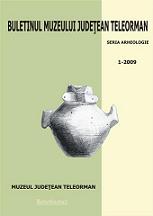HIGH-RESOLUTION STUDY AND RASTER INTERPOLATION OF EARLY NEOLITHIC PIT FEATURES AT MĂGURA ‘BUDUIASCA’,TELEORMAN COUNTY, SOUTHERN ROMANIA
HIGH-RESOLUTION STUDY AND RASTER INTERPOLATION OF EARLY NEOLITHIC PIT FEATURES AT MĂGURA ‘BUDUIASCA’,TELEORMAN COUNTY, SOUTHERN ROMANIA
Author(s): Mills SteveSubject(s): Archaeology
Published by: Editura Cetatea de Scaun
Keywords: Neolithic; pit features; micro-survey; GIS; raster surface
Summary/Abstract: The Southern Romania Archaeological Project (SRAP) conducted high-resolution total station spatial surveys of early Neolithic (5800-5600 cal. BC) sub-surface pit features at Mǎgura ‘Buduiasca’, Teleorman County, southern Romania in 2003 and 2004. The spatial data from these surveys were imported into the project Geographic Information System (GIS) and used to interpolate a raster surface of excavated and surveyed pit features. This provides a powerful, dynamic, resource for team members to visualise the three dimensional spatial relationships within and between pit features during the post-excavation phase. Ongoing GIS integration of geo-referenced photographs and plan drawings, and the wide range of additional spatial data derived from the excavation and post-excavation phases of the project (e.g. the distribution and character of associated material culture and dating and environmental samples), provides a multi-layered, flexible and navigable computer-based environment that considerably enhances the SRAP’s aim to address questions of the chronology, form and function of early Neolithic pit features. It is hoped that the wider adoption of high-resolution methodologies, as used by the SRAP at Mǎgura ‘Buduiasca’, will invigorate research into this important period of prehistory in the lower Danube region.
Journal: Buletinul Muzeului Judeţean Teleorman
- Issue Year: 2009
- Issue No: 1
- Page Range: 55-66
- Page Count: 12
- Language: English

